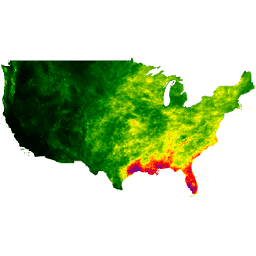
- Dostępność zbioru danych
- 1895-01-01T00:00:00Z–2020-12-01T00:00:00Z
- Dostawca zbioru danych
- PRISM / OREGONSTATE
- Cykl
- 1 miesiąc
- Tagi
Opis
Dzienne i miesięczne zbiory danych PRISM to dane klimatyczne w formie siatki dla kontynentalnej części Stanów Zjednoczonych, opracowane przez PRISM Climate Group na Oregon State University.
Siatki są tworzone za pomocą modelu PRISM (Parameter-elevation Regressions on Independent Slopes Model). Algorytmy interpolacji PRISM symulują, jak pogoda i klimat zmieniają się wraz z wysokością nad poziomem morza, i uwzględniają efekty przybrzeżne, inwersje temperatury i bariery terenowe, które mogą powodować cień opadowy. Dane ze stacji są zbierane z wielu sieci w całym kraju. Więcej informacji znajdziesz w opisach przestrzennych zbiorów danych klimatycznych PRISM.
Uwaga
- Ostrzeżenie: tego zbioru danych nie należy używać do obliczania stuletnich trendów klimatycznych ze względu na nieklimatyczne zmiany wynikające ze zmian wyposażenia i lokalizacji stacji, otwarcia i zamknięcia stacji, różnych godzin obserwacji oraz korzystania z sieci o stosunkowo krótkim okresie działania. Więcej informacji znajdziesz w dokumentacji zbioru danych .
- Zasoby zaczynają się o godzinie 12:00 czasu UTC, a nie o północy czasu UTC.
- Sieci obserwacyjne potrzebują czasu na przeprowadzenie kontroli jakości i udostępnienie danych ze stacji. Dlatego zbiory danych PRISM są ponownie modelowane kilka razy, aż do upływu 6 miesięcy, kiedy to są uznawane za stałe. Dostępny jest harmonogram udostępniania.
Pasma
Rozmiar piksela
4638,3 metra
Pasma
| Nazwa | Jednostki | Min. | Maksimum | Rozmiar piksela | Opis |
|---|---|---|---|---|---|
ppt |
mm | 0* | 2639,82* | metry | Łączna miesięczna ilość opadów (w tym deszczu i stopionego śniegu) |
tmean |
°C | –30,8* | 41,49* | metry | Średnia miesięczna średniej temperatury dziennej (obliczana jako (tmin+tmax)/2) |
tmin |
°C | –35,11* | 34,72* | metry | Miesięczna temperatura minimalna |
tmax |
°C | -29,8* | 49,74* | metry | Średnia miesięczna dzienna temperatura maksymalna |
tdmean |
°C | –30,7* | 26,76* | metry | Średnia miesięczna dzienna średnia temperatura punktu rosy |
vpdmin |
hPa | 0* | 44,79* | metry | Średnia miesięczna minimalnego dziennego deficytu ciśnienia pary |
vpdmax |
hPa | 0,009* | 110,06* | metry | Średnia miesięczna maksymalnego dziennego deficytu ciśnienia pary |
Właściwości obrazu
Właściwości obrazu
| Nazwa | Typ | Opis |
|---|---|---|
| PRISM_CODE_VERSION | CIĄG ZNAKÓW_LISTA | Lista wersji kodu dla każdego pasma, np. pierwszy element dotyczy pierwszego pasma „ppt”, drugi element dotyczy drugiego pasma „tmean”. |
| PRISM_DATASET_CREATE_DATE | CIĄG ZNAKÓW_LISTA | Lista dat utworzenia poszczególnych pasm w formacie RRRRMMDD. |
| PRISM_DATASET_FILENAME | CIĄG ZNAKÓW_LISTA | Lista oryginalnych nazw plików dla każdego pasma |
| PRISM_DATASET_TYPE | CIĄG ZNAKÓW_LISTA | Lista typów zbiorów danych według pasma |
| PRISM_DATASET_VERSION | CIĄG ZNAKÓW_LISTA | Lista wersji zbiorów danych według pasma, np.D1 lub D2 w przypadku produktów dziennych; M1, M2 lub M3 w przypadku produktów miesięcznych. |
Warunki korzystania z usługi
Warunki usługi
Te zbiory danych PRISM są dostępne bez ograniczeń dotyczących użycia lub dystrybucji. PRISM Climate Group wymaga, aby użytkownik podał odpowiednie źródło danych i w stosownych przypadkach wskazał PRISM jako źródło danych.
Cytaty
[Daly, C., J.I. Smith i K.V. Olson. 2015 r. Mapowanie klimatu wilgotności atmosferycznej na terenie kontynentalnych Stanów Zjednoczonych. PloS ONE 10(10):e0141140. doi:10.1371/journal.pone.0141140.
DOI
Odkrywaj za pomocą Earth Engine
Edytor kodu (JavaScript)
var dataset = ee.ImageCollection('OREGONSTATE/PRISM/AN81m') .filter(ee.Filter.date('2018-07-01', '2018-07-31')); var precipitation = dataset.select('ppt'); var precipitationVis = { min: 0.0, max: 300.0, palette: ['red', 'yellow', 'green', 'cyan', 'purple'], }; Map.setCenter(-100.55, 40.71, 4); Map.addLayer(precipitation, precipitationVis, 'Precipitation');
